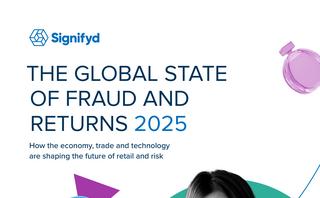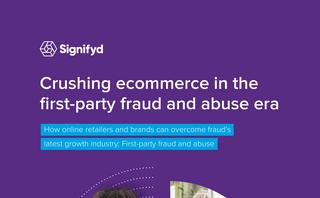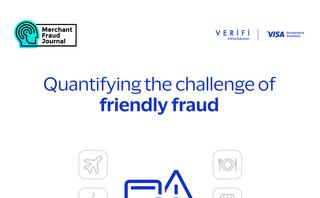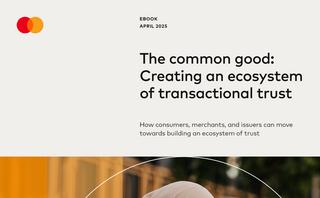87 notes tagged as ["fraud"]
Filter your results by choosing one or more tags below or type your query in the search field above.
-

Returns are growing in importance — with both retailers and consumers. To understand how these pressures are shaping the retail landscape, the National Retail Federation (NRF) and Happy Returns, a UPS company, explored both consumer and retailer perspectives and priorities for the returns experience. Key findings include:
Total returns for the retail industry are projected to reach $849.9 billion in 2025.
-

Discover the critical ecommerce fraud trends shaping 2025, from the surge in returns and card testing attacks to the industrialization of fraud and the impact of agentic commerce. The ecommerce fraud landscape is constantly shifting and fraudsters are constantly innovating. As a result, fraud pressure increased 13% by value in 2025, according to Signifyd data.
This report offers insights into the latest fraud schemes and protection. We look at the latest in return fraud, agentic commerce and explore regional trends in North America, the UK, Europe and Latin America.
-

Retailers have spent decades refining the online customer journey, optimising landing pages, streamlining checkout and layering in just enough friction to manage risk without losing conversions. But what happens when the customer no longer takes the journey at all?
That’s the shift agentic commerce represents. AI agents are beginning to act not as assistants but as autonomous actors, capable of initiating and completing purchases independently of the shopper.
-
You are currently enjoying the free trial mode which gives only back 3 results for each of your searches.
Click on Reset Search Tags to try another search.
Free NewsletterOnly paid members can get full access to the most recent content, create their own tags & personal folders, assign search results to specific projects and much more… all of this for less than 99c a day.
-

Explore the rise of first-party fraud and abuse in 2025
How online retailers and brands can overcome fraud’s latest growth industry: First‑party fraud and abuse. The evolving nature of first-party fraud has turned it into a multibillion-dollar threat. Organized fraud rings are leveraging digital loopholes, exploiting return policies, and using tactics such as refund-as-a-service platforms to target retailers. If your business isn’t prepared, you risk significant financial loss and damage to your reputation.
-

How to approach ID verification as ecommerce fraud increases
eCommerce fraud will rise from $44.3 billion in 2024 to $107 billion globally in 2029; a growth of 141%, according to Juniper Research. This has the potential for a significant negative impact on retailers’ bottom lines in an industry with tight margins, and also on their reputation.
This is putting ID verification processes firmly front and centre in the minds of retailers, even for those that sell low value items.
-

Quantifying the challenge of friendly fraud
More than 6 in 10 merchants cite an increase in first-party misuse (aka “friendly fraud”) over the past year. 2/3 of merchants with annual revenues greater than $1B use in-house dispute management methods rather than third-party services. This results in up to 34% greater revenue loss versus merchants who use third-party platforms to manage disputes.
Key takeaways and insights within the report include:
-

Future trends in payments: AI, fraud prevention, and real-time transaction monitoring
The payments industry is entering a critical new phase, where speed, security, and intelligence are no longer optional. Financial institutions must adapt to future trends in payments that prioritize real-time processing, AI-driven decision-making, and proactive fraud prevention. Customers now expect instant payments through rails like RTP®, FedNow®, and ACH, and regulators demand stronger compliance and risk management. Institutions that modernize their payment infrastructure today will secure a competitive advantage for the future.
-

Creating an ecosystem of transactional trust
Our latest report surveyed over 5,000 consumers and business decision-makers across the globe to understand their preferences for shopping online and sharing data. What we found? Consumers today want digital experiences to feel frictionless and easy — without sacrificing security or increasing chances of fraud. An almost impossible balancing act.
Learn how to improve the transaction experience with insights on:
-

Building trust, boosting growth: The latest insights in customer identity verification
The future of identity verification is full of pitfalls—and potential. As digital transactions become increasingly vulnerable to emerging threats, the demand for secure, frictionless customer assessment will only grow. To identify and prevent threats in real time without disrupting the customer experience, organizations must embrace best-in-class technologies and innovative solutions.
Our report, “Building trust, boosting growth,” dissects the transformative power of identity verification and shares actionable insights for unlocking new opportunities. Discover how AI-powered fraud prevention solutions can help not only tackle fraud but also navigate the complexities of identity, identifying more genuine customers —faster.
-

3 Ways AI is reshaping checkout experiences for SMBs
Checkout is no longer just the final step in a transaction — it’s where customers decide if they’ll return. And increasingly, it’s where artificial intelligence (AI) is raising the bar. Whether you run a neighborhood boutique or a growing e-commerce brand, AI is transforming the checkout experience from a routine transaction into a powerful competitive advantage. It’s driving faster, more flexible and more secure payment experiences while delivering the personalization today’s consumers expect.
-

The evolution of payments in retail and the rising importance of security
Customers mode of paying for goods and services has been revolutionized completely in the recent past. From the cash and check dominance to the emergence of digital wallets, cryptocurrencies, and Buy Now, Pay Later products, the payment landscape in retail is more complex and diversified than ever.
With this innovation, the increased threat of security comes into picture. Hacking, fraud, and theft of data are a big concern for both consumers and retailers.